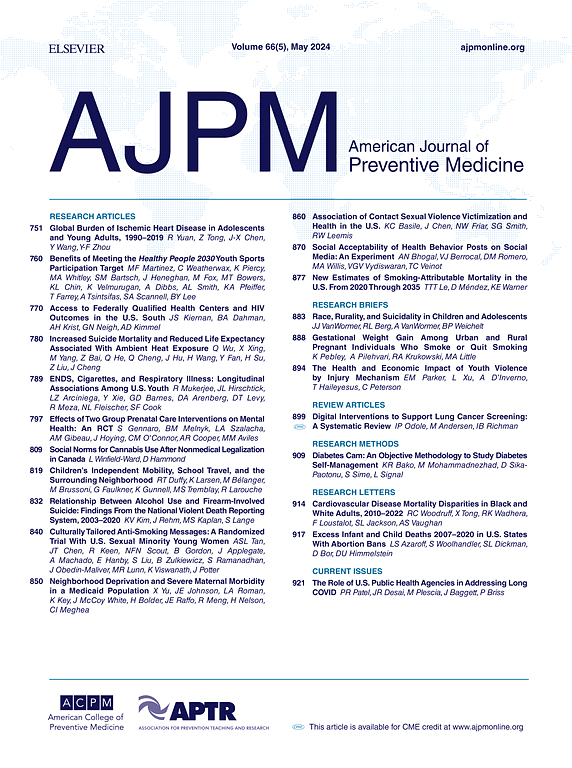Appropriateness of Immunoglobulin M Testing for Measles, Mumps, and Rubella
IF 4.3
2区 医学
Q1 MEDICINE, GENERAL & INTERNAL
引用次数: 0
Abstract
Introduction
Testing for immunity to measles, mumps, and rubella should include only immunoglobulin G (IgG); immunoglobulin M (IgM) testing is appropriate only if acute illness is suspected. The appropriateness of measles, mumps, and rubella IgM testing was evaluated in a national administrative dataset.
Methods
Laboratory testing for measles, mumps, and rubella during 2019–2022 was analyzed in 2024 using HealthVerity administrative claims and laboratory data. IgG, IgM, and reverse-transcriptase polymerase chain reaction (RT-PCR) testing are described by year, demographics, and region. IgM testing was examined for appropriateness, defined as an IgM test combined with diagnostic codes indicative of acute illness.
Results
During 2019–2022, IgM testing represented a small proportion of serologic testing (measles: 3.3%, mumps: 2.4%, rubella: 2.1%) but appeared to be appropriately performed in only 15.4% of cases for measles, 32.8% of cases for mumps, and 10.2% of cases for rubella. IgM testing was more commonly performed for female patients, with the largest discrepancy seen for rubella (90.5% female vs 9.5% male). IgM for measles and mumps was more often performed appropriately for persons aged 0–19 years (37.6% and 60.1%) compared with persons aged 20–49 years (11.8% and 22.0%) and 50+ years (16.5% and 33.8%).
Conclusions
The majority of IgM testing for measles, mumps, and rubella during this period appeared inappropriate. Clinicians and health systems could ensure that IgG testing alone is performed when evaluating for immunity through modifications to electronic medical records and commercial laboratories could ensure that providers are able to test for IgG alone when evaluating immunity.
麻疹、腮腺炎和风疹免疫球蛋白 M 检测的适宜性。
导言:麻疹、腮腺炎和风疹免疫力检测只应包括 IgG;IgM 检测仅适用于疑似急性疾病的情况。我们在全国行政数据集中对麻疹、腮腺炎和风疹 IgM 检测的适宜性进行了评估:利用 HealthVerity 行政报销和实验室数据分析了 2024 年 2019-2022 年期间麻疹、腮腺炎和风疹的实验室检测情况。按年份、人口统计学和地区描述了 IgG、IgM 和反转录聚合酶链反应 (RT-PCR) 检测。对 IgM 检测的适当性进行了研究,IgM 检测的定义是 IgM 检测与表明急性病的诊断代码相结合:2019-2022年期间,IgM检测在血清学检测中只占一小部分(麻疹:3.3%;腮腺炎:2.4%;风疹:2.1%),但似乎只有15.4%的麻疹病例、32.8%的腮腺炎病例和10.2%的风疹病例进行了适当的IgM检测。女性患者更常进行 IgM 检测,其中风疹检测的差异最大(90.5% 为女性,9.5% 为男性)。与 20-49 岁(11.8% 和 22.0%)和 50 岁以上(16.5% 和 33.8%)的人相比,0-19 岁的人更常进行适当的麻疹和腮腺炎 IgM 检测(37.6% 和 60.1%):结论:在此期间,大多数麻疹、腮腺炎和风疹的 IgM 检测似乎并不恰当。临床医生和医疗系统可通过修改电子病历确保在评估免疫力时只进行 IgG 检测,商业实验室可确保医疗服务提供者在评估免疫力时只进行 IgG 检测。
本文章由计算机程序翻译,如有差异,请以英文原文为准。
求助全文
约1分钟内获得全文
求助全文
来源期刊

American Journal of Preventive Medicine
医学-公共卫生、环境卫生与职业卫生
CiteScore
8.60
自引率
1.80%
发文量
395
审稿时长
32 days
期刊介绍:
The American Journal of Preventive Medicine is the official journal of the American College of Preventive Medicine and the Association for Prevention Teaching and Research. It publishes articles in the areas of prevention research, teaching, practice and policy. Original research is published on interventions aimed at the prevention of chronic and acute disease and the promotion of individual and community health.
Of particular emphasis are papers that address the primary and secondary prevention of important clinical, behavioral and public health issues such as injury and violence, infectious disease, women''s health, smoking, sedentary behaviors and physical activity, nutrition, diabetes, obesity, and substance use disorders. Papers also address educational initiatives aimed at improving the ability of health professionals to provide effective clinical prevention and public health services. Papers on health services research pertinent to prevention and public health are also published. The journal also publishes official policy statements from the two co-sponsoring organizations, review articles, media reviews, and editorials. Finally, the journal periodically publishes supplements and special theme issues devoted to areas of current interest to the prevention community.
 求助内容:
求助内容: 应助结果提醒方式:
应助结果提醒方式:


